The golden years should be a time of peace and comfort, yet for many, financial strain can overshadow this chapter of life. For older adults on a limited budget, navigating the complex web of available support can feel overwhelming. This guide is designed to provide clear, actionable information, offering a lifeline to those seeking stability and a better quality of life. We have compiled and analyzed 12 vital resources that provide help for seniors with low income, cutting through the confusion to connect you with the aid you need.
This resource list serves as a direct roadmap to financial assistance. We cover everything from healthcare and housing to nutrition and utility bills. Each entry provides a detailed breakdown of the program, its specific benefits, eligibility requirements, and direct application guidance. To make the process even simpler, we've included screenshots to help you navigate the websites and direct links to get you started immediately.
Understanding these programs is the first step toward securing the financial assistance and services you or your loved ones deserve. Whether you are a senior, a family caregiver, or a healthcare professional, this comprehensive list will help you identify and access the most suitable support options available, simplifying your search and empowering you to make informed decisions.
1. NJ Caregiving
NJ Caregiving establishes itself as a premier resource, particularly for residents of Princeton and Mercer County, NJ, seeking comprehensive in-home care. The platform is an essential destination for families navigating the complexities of elder care, especially those looking for help for seniors with low income who may qualify for state-funded programs. It offers a direct pathway to personalized care plans that encompass everything from basic companionship and personal assistance to specialized nursing and on-site physician support.
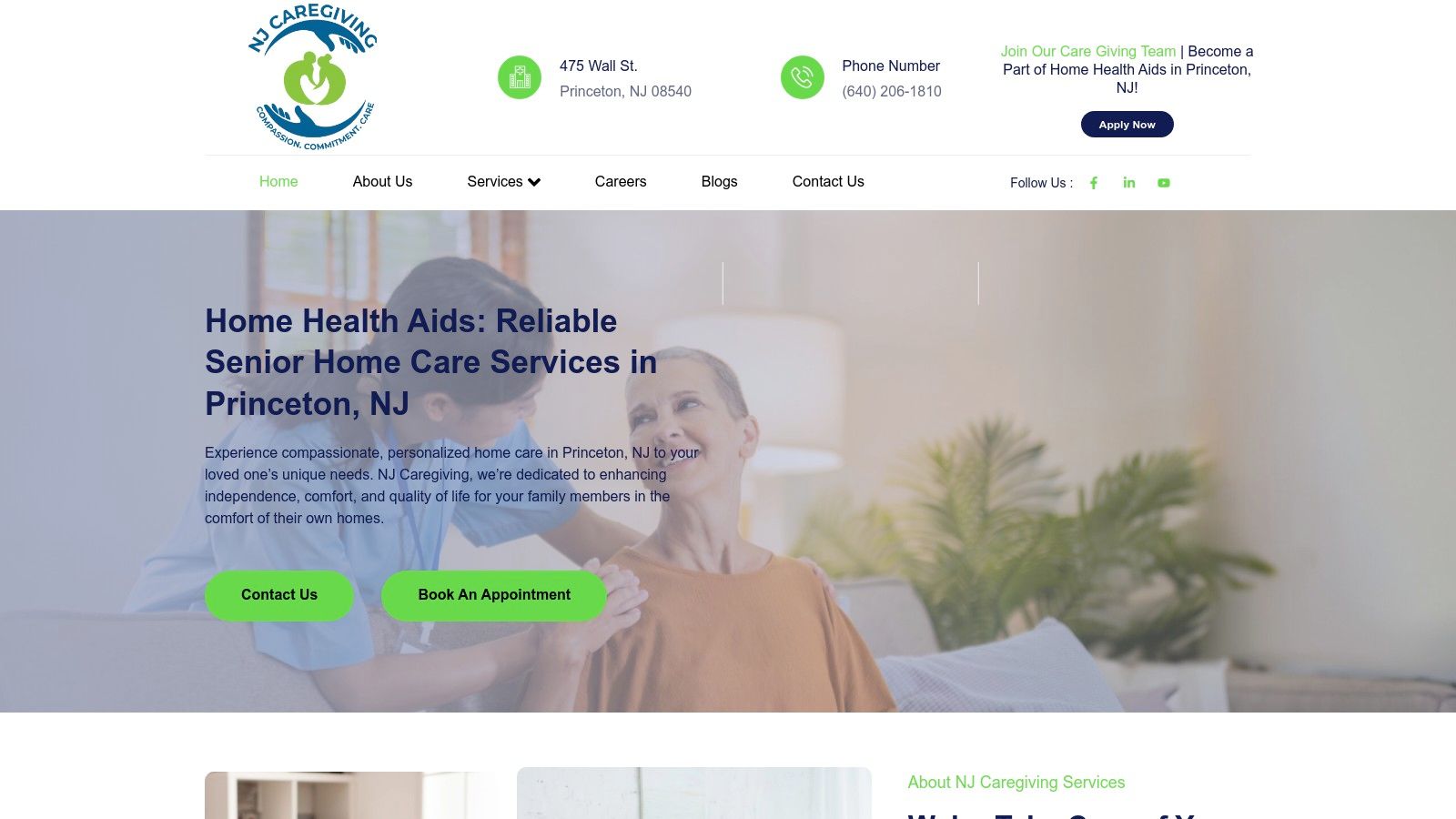
What truly distinguishes NJ Caregiving is its dual expertise in both care provision and financial navigation. The organization provides invaluable, expert guidance on Medicaid eligibility, helping families understand and apply for benefits that can fully or partially cover the cost of in-home services. This integrated approach removes a significant barrier for many, transforming high-quality care from a financial burden into an accessible reality.
Key Strengths & Practical Benefits
- Medicaid Navigation: A standout feature is their hands-on assistance with the Medicaid application process. This is a critical service for low-income seniors who may find the system overwhelming, ensuring they can access the financial support they are entitled to.
- Comprehensive Service Spectrum: Unlike agencies that offer limited services, NJ Caregiving provides a holistic range including personal care, skilled nursing, respite for family caregivers, and even on-site physician visits, making it a one-stop solution.
- Flexible and Accessible: They accommodate both private-pay clients and Medicaid beneficiaries, offering 24/7 availability that provides peace of mind for families needing round-the-clock support.
Considerations
While NJ Caregiving excels in service quality and financial guidance, specific pricing is not available on the website and requires a direct consultation. Additionally, their primary service area is focused on Princeton and Mercer County, which limits access for those outside this region.
2. BenefitsCheckUp by the National Council on Aging
The National Council on Aging’s (NCOA) BenefitsCheckUp is a powerful, free, and confidential online tool specifically designed to connect older adults with benefit programs. It serves as a one-stop shop, eliminating the need to search through countless individual agency websites. This resource is essential for anyone seeking comprehensive help for seniors with low income, as it screens for over 2,500 federal, state, and local programs.
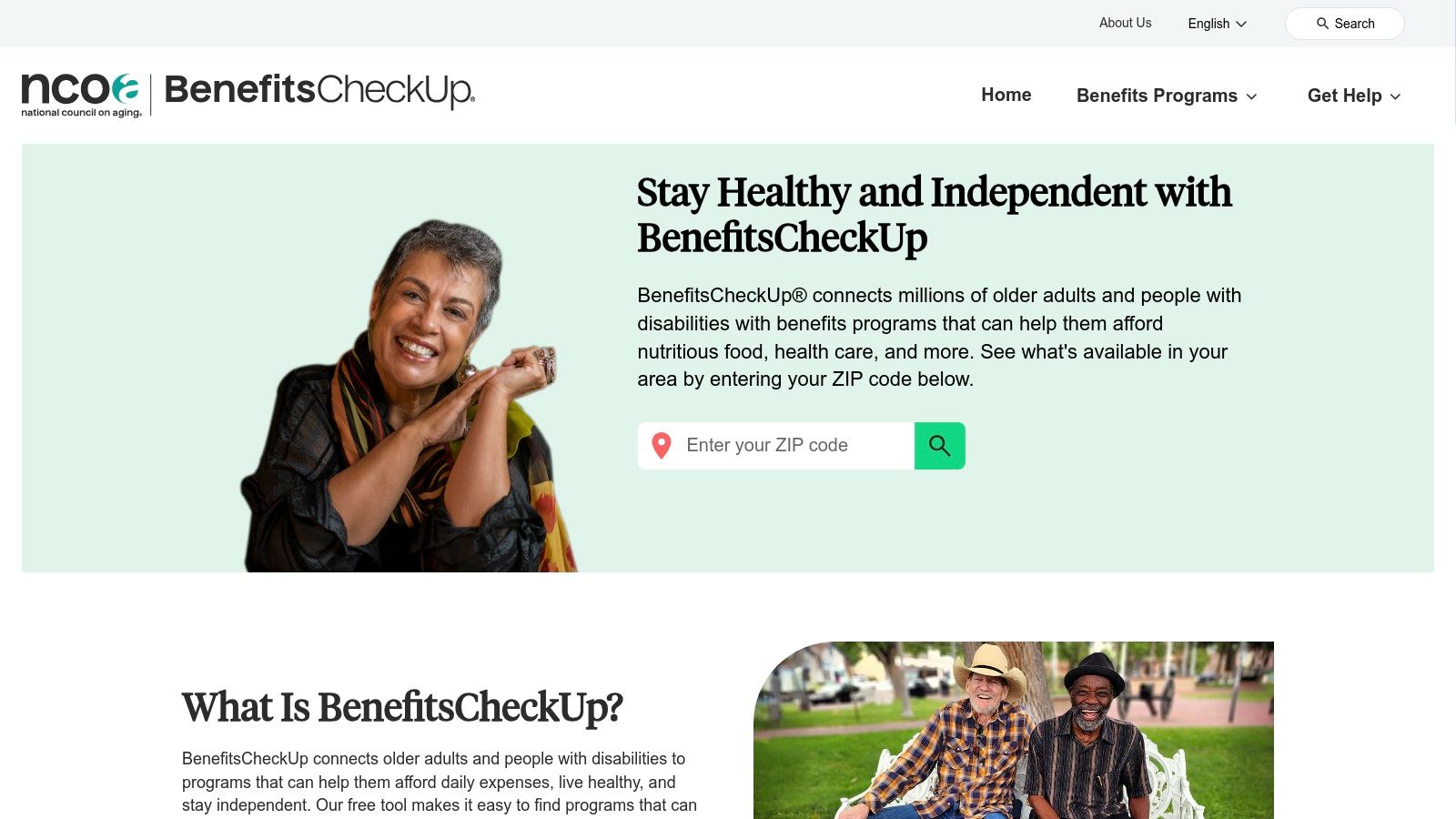
The platform’s standout feature is its personalized approach. Users answer a series of questions about their financial situation, location, and health status. In return, BenefitsCheckUp generates a detailed, customized report outlining programs they are likely eligible for, complete with application information and direct links.
Key Features and Usage Tips
- Comprehensive Screening: Covers everything from healthcare and prescription drugs (Medicare Savings Programs, Extra Help) to nutrition (SNAP), housing, and utility assistance (LIHEAP).
- User-Friendly Interface: The questionnaire is straightforward and easy to navigate, making it accessible even for those with limited technical skills.
- Practical Tip: Have basic financial information ready, such as monthly income and asset estimates, to get the most accurate results. If internet access is a barrier, a family member, caregiver, or local senior center staff member can easily assist with completing the assessment online.
Website: https://www.benefitscheckup.org/
3. Eldercare Locator by the U.S. Administration on Aging
The Eldercare Locator is a public service from the U.S. Administration on Aging connecting older adults and caregivers to a vast network of local support services. Instead of listing federal programs, its primary function is to act as a bridge to community-based organizations that provide hands-on assistance. This makes it a crucial resource for finding tangible, local help for seniors with low income, covering everything from transportation and meals to in-home care and legal aid.

What sets this platform apart is its direct link to Area Agencies on Aging and other local service providers. By entering a zip code or city, users are instantly connected with trusted, on-the-ground support. The service is completely free and accessible online, by phone, or via online chat, ensuring everyone can find the help they need regardless of technical ability.
Key Features and Usage Tips
- Hyper-Local Focus: Excels at finding services in your immediate community, such as senior centers, meal delivery (Meals on Wheels), and transportation options.
- Multiple Access Points: Users can call their toll-free number, use the online chat, or search the website, which is helpful for seniors with varying comfort levels with technology.
- Practical Tip: Be prepared to make phone calls. The website provides contact information for local agencies, which often require a direct conversation to assess needs and eligibility. This human touch is a core part of their service model.
Website: https://eldercare.acl.gov/
4. Meals on Wheels America
Meals on Wheels America is a vital lifeline that addresses two of the most significant challenges facing older adults: hunger and isolation. The organization operates through a vast network of community-based programs across the country, delivering nutritious meals directly to the homes of seniors who are unable to shop or cook for themselves. This service is a cornerstone of support, providing essential help for seniors with low income by ensuring they have access to healthy, reliable food sources.
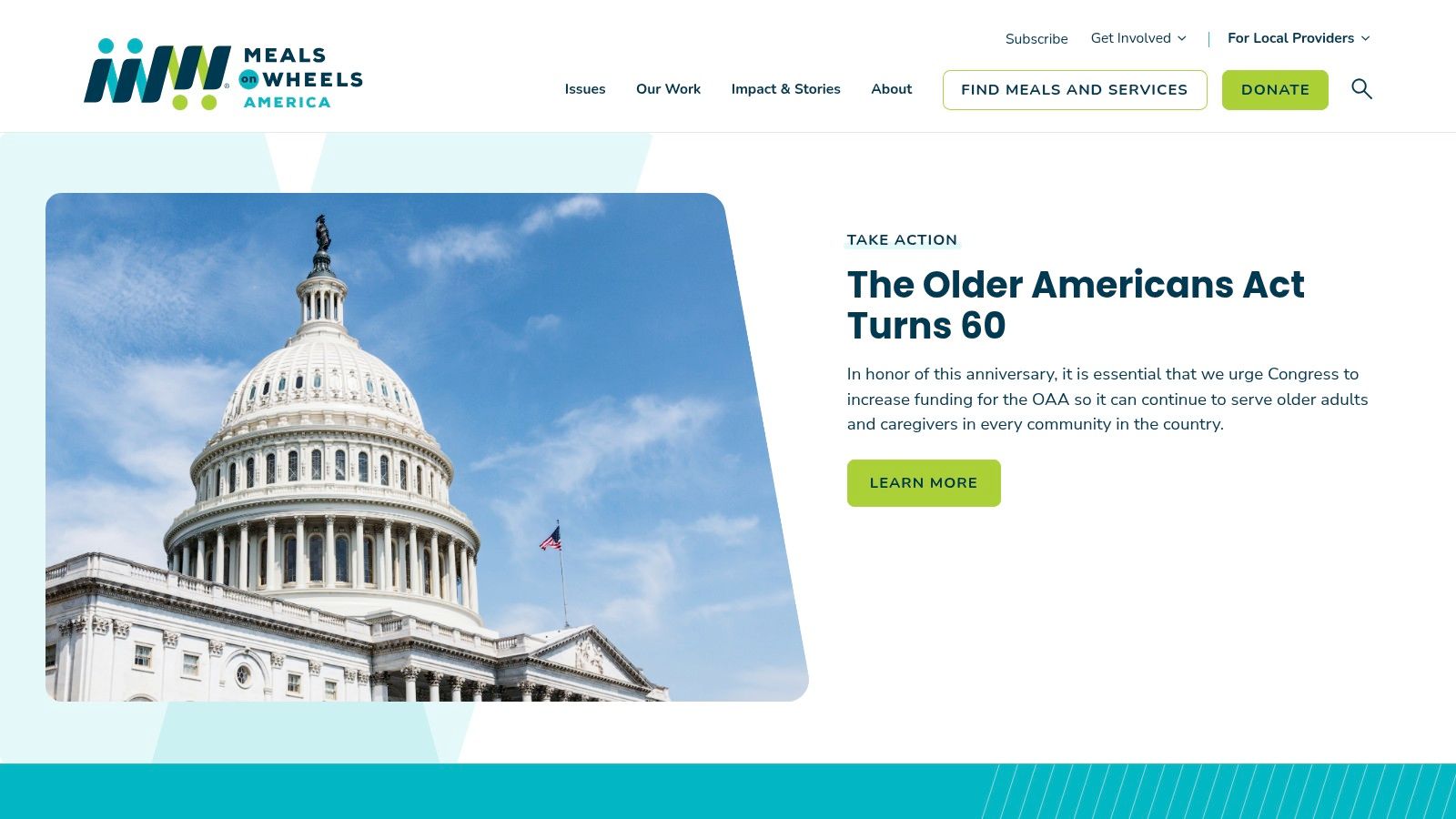
The platform's unique strength lies in its dual-purpose model. Beyond just food delivery, the friendly visit from a volunteer serves as a crucial safety check and a moment of social connection for homebound individuals. This regular interaction can combat feelings of loneliness and provide peace of mind for both the senior and their loved ones.
Key Features and Usage Tips
- Holistic Support: Combines nutritional assistance with valuable social interaction and safety checks, addressing both physical and emotional well-being.
- Nationwide Network: With over 5,000 local programs, services are tailored to the community, though availability and specific meal options may vary by location.
- Practical Tip: To find a local provider, use the "Find a Meal" search tool on their website. Since each program operates independently, it's best to contact your local branch directly to inquire about eligibility, meal plans, and any potential costs, which are often based on a sliding scale.
Website: https://www.mealsonwheelsamerica.org/
5. Supplemental Nutrition Assistance Program (SNAP)
The Supplemental Nutrition Assistance Program (SNAP), managed by the U.S. Department of Agriculture, is a cornerstone of federal food aid. It provides monthly benefits on an Electronic Benefit Transfer (EBT) card, which functions like a debit card at authorized stores. This program is critical help for seniors with low income, ensuring they can afford groceries and maintain a nutritious diet, which is vital for overall health and well-being.
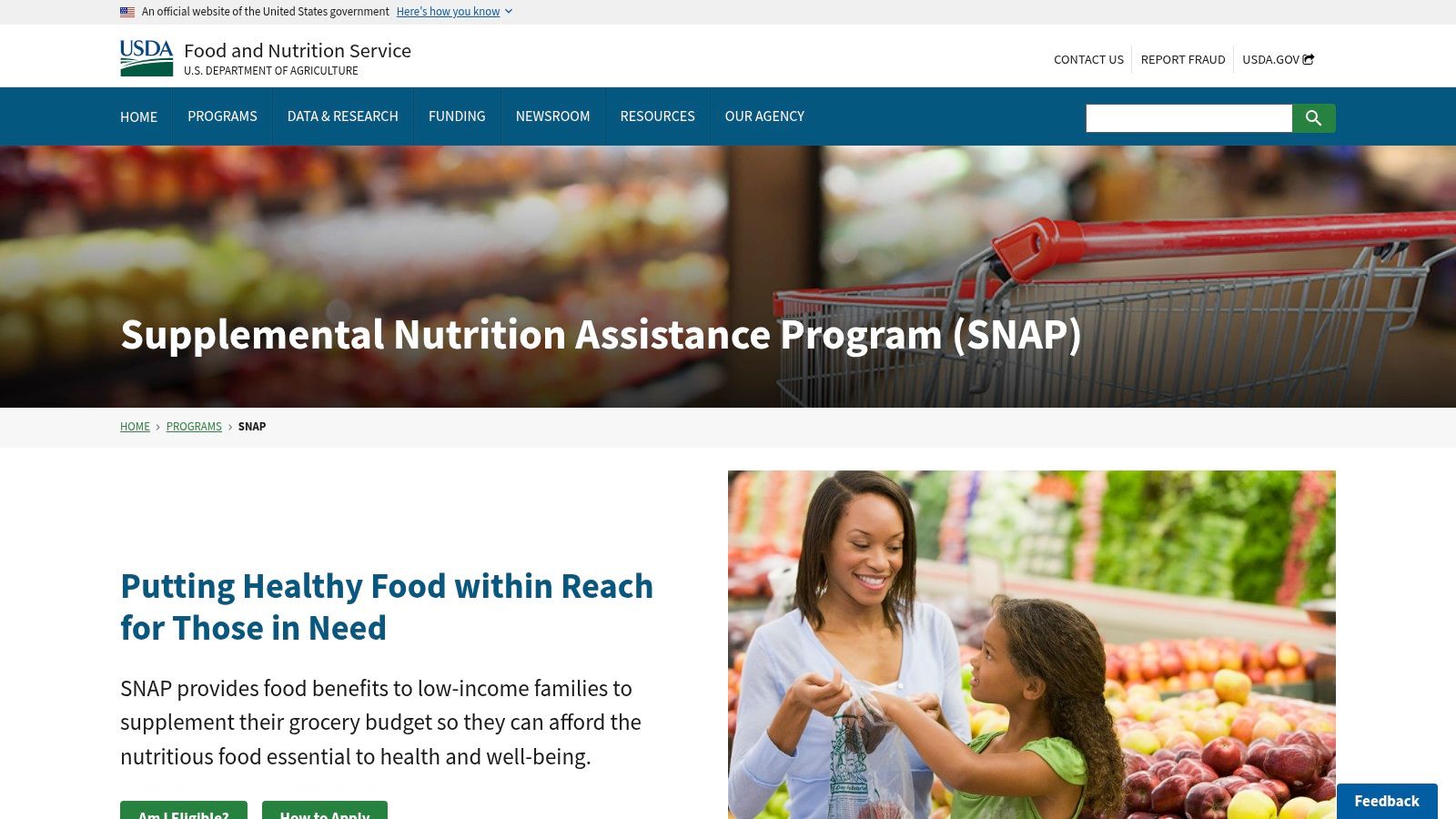
What makes SNAP essential is its widespread acceptance and specific provisions designed for older adults. The USDA's website serves as the central hub for information, directing applicants to their state-specific agency to apply. For seniors, this resource helps overcome food insecurity by providing a consistent, dignified way to purchase food from most grocery stores, farmers' markets, and even some online retailers.
Key Features and Usage Tips
- Broad Eligibility: While income-based, states often have special rules for households with members who are 60 or older, which can make it easier to qualify.
- Widespread Acceptance: The EBT card is accepted at thousands of retailers nationwide, providing flexibility and choice in where to shop for groceries.
- Practical Tip: The application is managed at the state level. Use the USDA's state directory to find your local SNAP office. Many states offer simplified, shorter applications for seniors, so be sure to ask if one is available. A local Area Agency on Aging can also provide free application assistance.
Website: https://www.fns.usda.gov/snap
6. Low-Income Home Energy Assistance Program (LIHEAP)
The Low-Income Home Energy Assistance Program (LIHEAP) is a crucial federal initiative providing direct financial help for seniors with low income struggling with energy costs. Administered by states, territories, and tribes, this program helps ensure that vulnerable households, particularly those with elderly members, can maintain safe and healthy indoor temperatures throughout the year. It's a vital resource for preventing utility disconnections and managing high heating and cooling bills.

The program's strength lies in its multi-faceted approach. Beyond one-time bill payment assistance, LIHEAP can intervene in energy crises, such as a pending shutoff notice or a broken furnace. It also funds weatherization services, a long-term solution that improves a home's energy efficiency, leading to sustained cost savings. The official website directs users to their local state office to begin the application process.
Key Features and Usage Tips
- Diverse Assistance: Offers help with regular heating and cooling bills, crisis intervention for utility emergencies, and home weatherization services.
- State-Level Administration: Eligibility and application processes vary by state. The website provides a directory to find your local LIHEAP office and specific requirements.
- Practical Tip: Since funding is limited and often distributed on a first-come, first-served basis, apply as soon as the application period opens in your state. Keep copies of recent utility bills and proof of income readily available to streamline your application.
Website: https://www.acf.hhs.gov/ocs/low-income-home-energy-assistance-program-liheap
7. Housing Choice Voucher Program (Section 8)
The Housing Choice Voucher Program, commonly known as Section 8, is a cornerstone of federal housing assistance. Administered by the U.S. Department of Housing and Urban Development (HUD), it provides essential help for seniors with low income by subsidizing rent in the private market. This program empowers participants to choose their own safe and sanitary housing, including single-family homes, townhouses, and apartments, rather than being limited to specific subsidized housing projects.
The program's key benefit is affordability. Participants typically pay about 30% of their monthly adjusted income towards rent and utilities, while the voucher covers the remainder directly to the landlord. This model supports independent living and offers flexibility, allowing seniors to find housing that best suits their needs, often in their existing communities.
Key Features and Usage Tips
- Rental Subsidy: The core feature is the rental voucher that makes market-rate housing affordable for low-income individuals and families.
- Housing Choice: Unlike public housing, participants find their own rental unit, which must meet the program's health and safety standards.
- Practical Tip: Waiting lists for Section 8 are notoriously long, sometimes lasting for years. It is crucial to apply to your local Public Housing Agency (PHA) as soon as possible. Check the HUD website to find your local PHA and see if their waiting list is open.
Website: https://www.hud.gov/program_offices/public_indian_housing/programs/hcv/about
8. Senior Farmers' Market Nutrition Program (SFMNP)
The Senior Farmers' Market Nutrition Program (SFMNP) is a unique federal initiative offering direct help for seniors with low income by promoting both health and community engagement. Administered by State agencies, the program provides eligible seniors with coupons or electronic benefit cards that can be exchanged for fresh, unprepared, locally grown fruits, vegetables, honey, and herbs. This resource directly tackles nutritional gaps by making healthy, fresh produce more accessible while simultaneously supporting local farmers and economies.
The program's strength lies in its simplicity and dual benefit. It not only improves dietary health among older adults but also fosters social connections by encouraging visits to community farmers' markets, roadside stands, and community-supported agriculture programs. Eligibility is typically based on age (usually 60 or older) and an income at or below 185% of the federal poverty line, though this can vary by state.
Key Features and Usage Tips
- Nutritional Focus: Specifically targets fresh, locally sourced produce, encouraging healthier eating habits and providing essential vitamins and minerals.
- Community Connection: Supports local agriculture and creates opportunities for seniors to engage with their community at local markets.
- Practical Tip: Since this is a state-run program, availability and application processes differ. The USDA website provides a directory of state contacts. It's best to check with your local or state agency on aging early in the year, as funds are limited and often distributed on a first-come, first-served basis.
Website: https://www.fns.usda.gov/sfmnp/senior-farmers-market-nutrition-program
9. Lifeline Program by the Federal Communications Commission (FCC)
The FCC's Lifeline program is a crucial federal initiative providing essential communication services to low-income households. For older adults, having a reliable phone or internet connection is not a luxury; it's a lifeline for emergency services, telehealth appointments, and staying connected with family. This program offers a direct monthly discount, making these vital services more affordable and accessible, which is a significant form of help for seniors with low income.

This platform stands out by directly subsidizing the cost of connectivity through participating phone and internet companies. Seniors can apply for a discount of up to $9.25 per month on either a landline, mobile phone, or internet service. This focused approach ensures that budget constraints do not force seniors into isolation or prevent them from accessing critical digital resources.
Key Features and Usage Tips
- Service Flexibility: The discount can be applied to either a home phone, a mobile phone (voice and data), or a broadband internet service, allowing seniors to choose what best suits their needs.
- Nationwide Availability: As a federal program, Lifeline is available in every state, territory, and on Tribal lands, where an enhanced discount of up to $34.25 per month is available.
- Practical Tip: To apply, you can use the National Verifier online portal or contact a participating service provider directly. Eligibility is often based on participation in other federal assistance programs like SNAP or Medicaid, so have proof of enrollment handy to simplify the process.
Website: https://www.fcc.gov/lifeline
10. Supplemental Security Income (SSI) by the Social Security Administration
The Social Security Administration’s (SSA) website is the official portal for the Supplemental Security Income (SSI) program, a crucial federal resource providing monthly payments to adults aged 65 or older with very limited income and resources. Unlike regular Social Security benefits based on work history, SSI is a needs-based program designed to cover basic necessities like food, clothing, and shelter. This makes it a foundational form of help for seniors with low income who may not qualify for other retirement benefits.
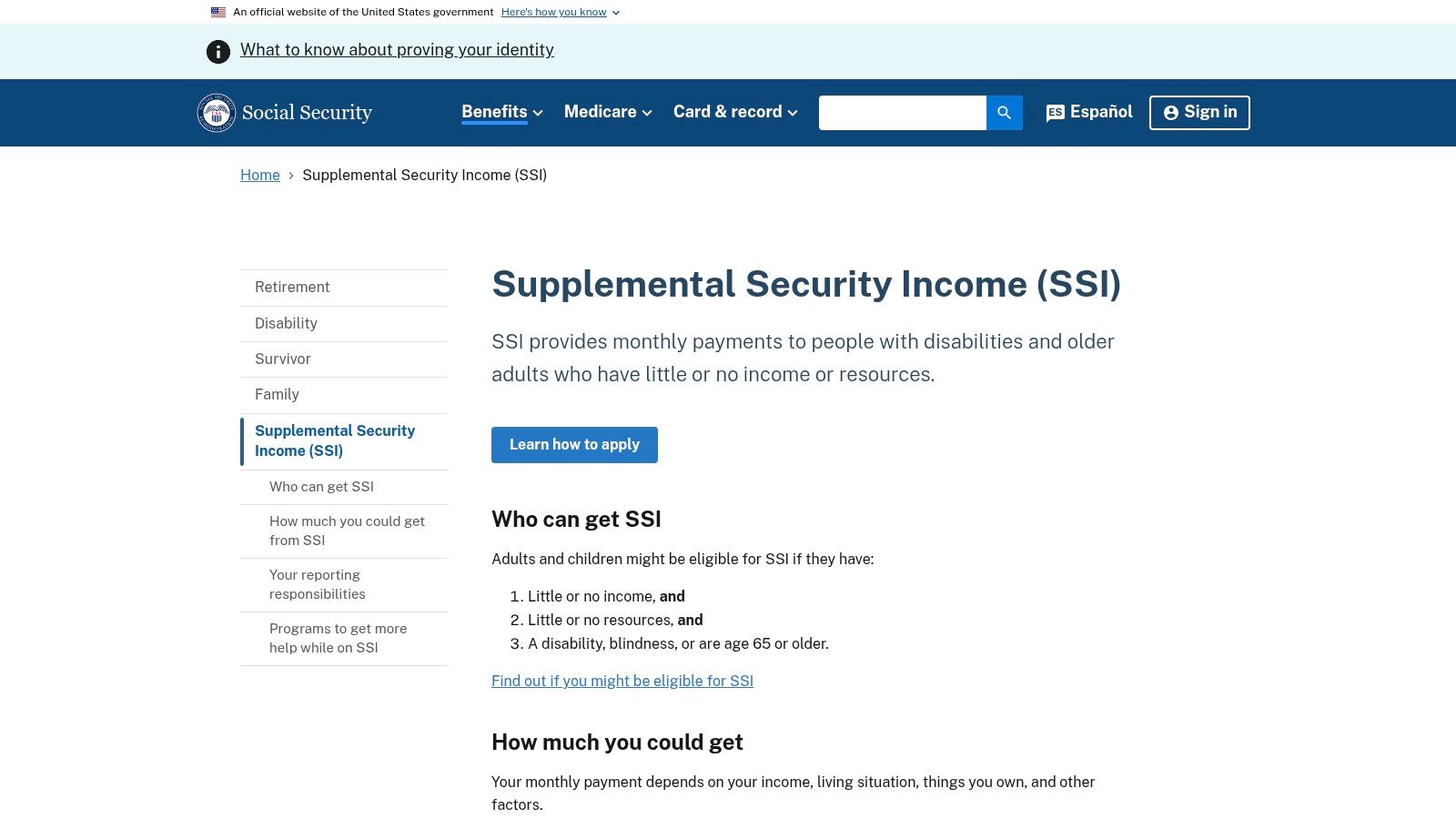
The SSA website provides comprehensive information, eligibility screeners, and online application tools. A significant advantage is that in most states, qualifying for SSI automatically makes a senior eligible for Medicaid, securing vital healthcare coverage. The platform is the direct source for managing this essential financial safety net.
Key Features and Usage Tips
- Direct Financial Assistance: Provides a monthly cash payment to help vulnerable seniors meet essential living expenses.
- Automatic Medicaid Eligibility: In most states, SSI recipients are automatically enrolled in Medicaid, removing a major barrier to healthcare access.
- Practical Tip: The application process can be lengthy and requires detailed documentation of income, resources, and living arrangements. Use the SSA’s online checklists to gather all necessary documents before starting your application to avoid delays. Consider contacting a local Area Agency on Aging for free application assistance.
Website: https://www.ssa.gov/ssi/
11. Senior Community Service Employment Program (SCSEP)
The Senior Community Service Employment Program (SCSEP) provides crucial "earn while you learn" opportunities for older Americans. Administered by the U.S. Department of Labor, this program offers subsidized, part-time community service training for low-income, unemployed individuals aged 55 or older. It is a vital form of help for seniors with low income, allowing them to gain valuable work skills, build confidence, and earn a modest stipend to supplement their finances.
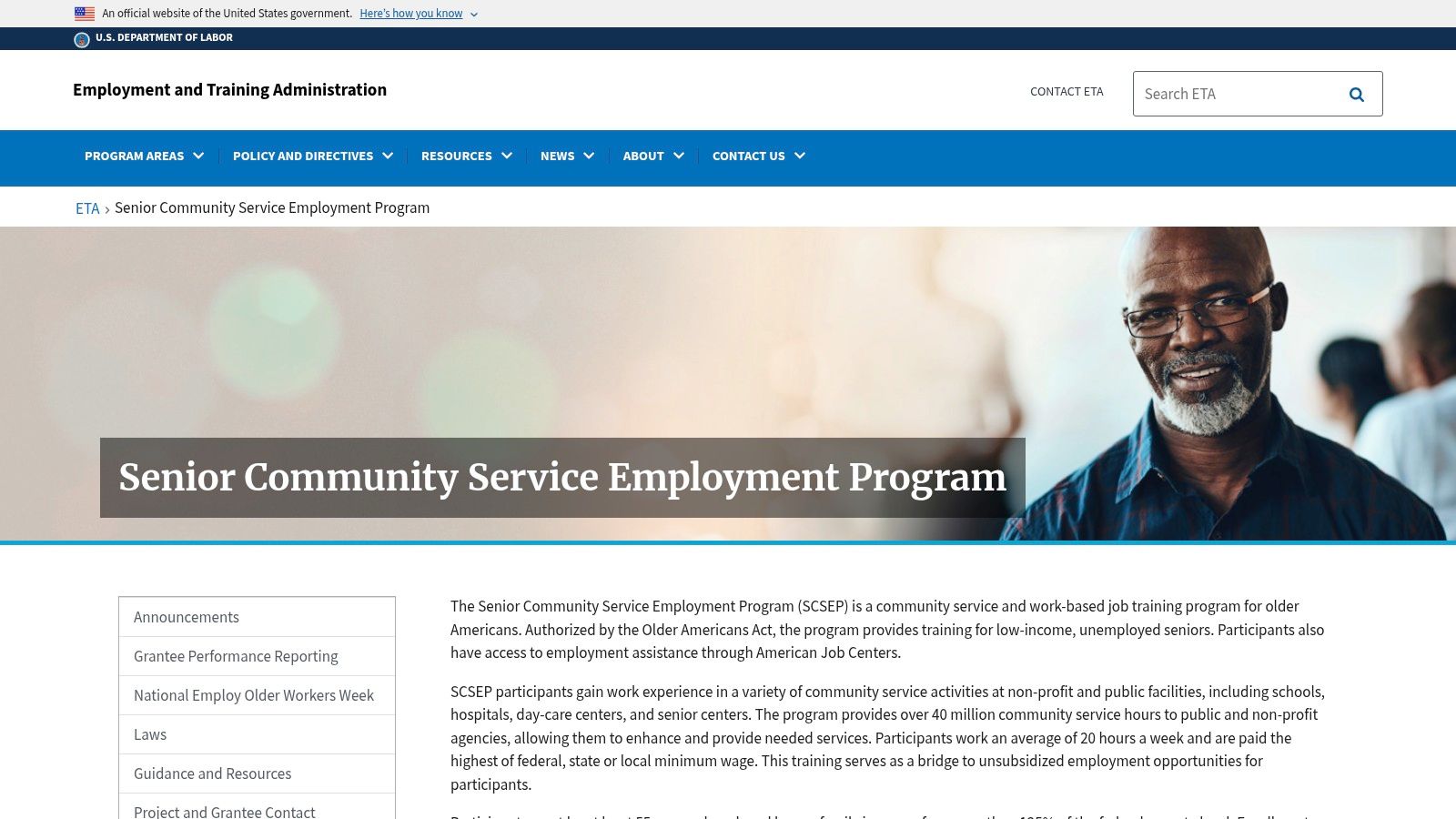
What makes SCSEP unique is its dual focus on individual and community benefit. Participants are placed in public agencies or nonprofit organizations, such as schools, hospitals, and senior centers, where they contribute to the community while updating their job skills. This hands-on experience is designed to be a bridge to unsubsidized employment, empowering seniors to re-enter the workforce.
Key Features and Usage Tips
- Paid Training: Participants work an average of 20 hours per week and are paid at least the highest of the federal, state, or local minimum wage.
- Diverse Placements: Training assignments are available in various community service sectors, including office administration, customer service, and child care.
- Practical Tip: To find a local SCSEP project, use the CareerOneStop Older Worker Program Finder linked on the Department of Labor's website. Be aware that program slots are limited, so it is best to inquire about availability and potential waiting lists in your area.
Website: https://www.dol.gov/agencies/eta/seniors
12. Area Agencies on Aging (AAA)
Area Agencies on Aging (AAA) are a nationwide network of local organizations dedicated to addressing the needs and concerns of older adults at the community level. Rather than a single website, the AAA network serves as a crucial, on-the-ground access point for a wide range of support services. This hyper-local focus makes them an indispensable resource for finding help for seniors with low income, as they connect individuals with programs and assistance tailored specifically to their immediate area.
The primary strength of the AAA network is its role as a local information and referral hub. Instead of navigating complex systems alone, seniors and their caregivers can contact their local AAA for direct guidance on services like in-home care, meal programs (Meals on Wheels), transportation, and legal aid. They act as navigators, connecting people to the specific resources available in their town or county.
Key Features and Usage Tips
- Community-Specific Services: Connects seniors with vital local services, including transportation, nutrition programs, caregiver support, and health promotion classes.
- Information and Assistance: Provides personalized guidance on navigating benefits and understanding what local, state, and federal programs are available.
- Practical Tip: Use the Eldercare Locator, linked below, to find the contact information for your specific regional AAA. Services can vary significantly between locations, so direct contact is the best way to understand what support is currently offered.
Website: https://eldercare.acl.gov/Public/About/Aging_Network/AAA.aspx
12 Key Resources Comparison for Low-Income Seniors
| Service / Program | Core Features / Services | User Experience & Quality | Value & Pricing | Target Audience | Unique Selling Points |
|---|---|---|---|---|---|
| 🏆 NJ Caregiving | Personalized in-home care, nursing, respite, companionship ✨ | Highly skilled staff ★★★★☆ | Affordable, flexible 💰 | Seniors, disabled 👥 | 24/7 availability, Medicaid help ✨ |
| BenefitsCheckUp (National Council on Aging) | Online benefits screening for 2,500+ programs | Easy to use, updated regularly ★★★★☆ | Free 💰 | Seniors seeking aid 👥 | Comprehensive benefit database |
| Eldercare Locator (U.S. Administration on Aging) | Nationwide service directory, phone & online support | Trustworthy, multilingual ★★★★ | Free 💰 | Older adults & families 👥 | Direct link to local resources |
| Meals on Wheels America | Home-delivered meals, safety checks, social interaction | Volunteer-driven, community-focused ★★★★☆ | Typically free or low-cost 💰 | Homebound seniors 👥 | Combats hunger & isolation |
| SNAP | Monthly food benefits via EBT card | Widely accepted, improves nutrition ★★★★ | Financial assistance 💰 | Low-income individuals 👥 | Food security for seniors |
| LIHEAP | Energy bill assistance, weatherization services | Essential support for utilities ★★★★ | Financial aid 💰 | Low-income households 👥 | Emergency energy support |
| Housing Choice Voucher (Section 8) | Rental subsidies, housing choice | Flexible housing options ★★★★ | Subsidized rent 💰 | Low-income seniors 👥 | Independent affordable housing |
| Senior Farmers' Market Nutrition Program (SFMNP) | Coupons for fresh produce | Simple application ★★★★ | Food vouchers 💰 | Low-income seniors 👥 | Supports local farmers |
| Lifeline Program (FCC) | Phone/internet discounts for low-income users | Nationwide, supports telehealth ★★★★ | Monthly discount 💰 | Low-income seniors 👥 | Essential connectivity support |
| Supplemental Security Income (SSI) | Monthly cash payments, Medicaid eligibility | Safety net for vulnerable seniors ★★★★ | Financial assistance 💰 | Seniors 65+, disabled 👥 | Automatic Medicaid eligibility |
| Senior Community Service Employment Program (SCSEP) | Job training & part-time employment | Builds skills and income ★★★★ | Paid stipends 💰 | Low-income seniors 55+ 👥 | Community engagement |
| Area Agencies on Aging (AAA) | Local meal, transport, caregiver support | Tailored local help ★★★★ | Mostly free/low-cost 💰 | Seniors & caregivers 👥 | One-stop local senior services |
Putting It All Together: Your Action Plan for a Secure Future
Navigating the landscape of financial assistance can feel like assembling a complex puzzle, but this guide has provided you with the essential pieces. The journey to securing stability and support is not about finding a single magic bullet; it's about building a customized, multi-layered safety net. The most effective approach combines federal programs, state-specific aid, and local community resources to address your unique needs.
The sheer volume of available help for seniors with low income can be intimidating, but you don't have to tackle it all at once. The key is to start strategically. By identifying your most pressing needs first, whether it's for food, housing, healthcare, or utilities, you can focus your energy where it matters most. This targeted strategy prevents overwhelm and leads to more tangible, immediate results.
Your Actionable Next Steps
Creating a secure future requires a proactive stance. Waiting for a crisis to occur is far more stressful than methodically putting supports in place now. Here is a simple, step-by-step plan to get started:
-
Start with a Comprehensive Assessment: Begin with the BenefitsCheckUp tool from the National Council on Aging. This is your starting point for discovery. It will generate a personalized list of federal, state, and private benefits you may be eligible for, saving you countless hours of research.
-
Connect with Local Experts: Your next call should be to your local Area Agency on Aging (AAA), which you can find using the Eldercare Locator. These counselors offer invaluable, on-the-ground guidance, helping you understand local nuances, navigate application processes, and connect with services like Meals on Wheels or Senior Farmers' Market Nutrition Programs.
-
Layer Your Support System: Do not rely on a single program. A robust plan might involve combining SSI for monthly income, SNAP for groceries, LIHEAP for utility bills, and a Housing Choice Voucher for affordable living. Each program is a building block in your financial foundation.
-
Be Persistent and Patient: Application processes for programs like Section 8 or Medicaid can be lengthy and complex. Do not be discouraged by waitlists, paperwork, or initial denials. Persistence is crucial. Follow up, keep organized records, and ask for help from your AAA or a trusted advocate when needed. The support is there, but it often requires determination to access.
Ultimately, taking control of your financial well-being is an empowering act. By leveraging the tools and programs detailed in this article, you are not just finding aid; you are actively building a more secure, dignified, and comfortable future for yourself or your loved one. The help exists, and your journey begins with that first proactive step.
For seniors in New Jersey seeking personalized, in-home care solutions that align with Medicaid benefits, NJ Caregiving can help. We specialize in navigating the complexities of state-funded programs to provide the compassionate support you need to age in place safely and with dignity. Visit NJ Caregiving to learn how we can assist your family.



